
- Home
- Travel Packages
- Top Destination
-
Travel Attraction
By Category
Top Attraction

- Travel Agents
- Car Rentals
- Hotels
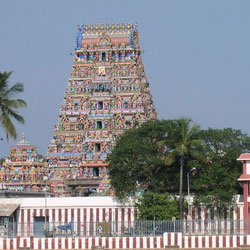
About the Kapaleeswarar Temple The Kapaleeswarar Temple, located in Mylapore, Chennai, is a revered Hindu temple dedicated to Lord Shiva. The temple is renowned for its magnificent Dravidian style architecture and is a significant religious site for devotees from all over the world. The temple is believed to have been built around the 7th century by the Pallava dynasty and remains an important pilgrimage destination in South India. Architecture of Kapaleeswarar Temple The Kapaleeswarar Temple showcases the classic Dravidian style of architecture with its impressive gopurams, mandapams, and intricate sculptures. The main entrance of the temple is adorned with a towering gopuram that is intricately carved with images of Hindu deities and mythological figures. The inner sanctum of the temple houses the main deity, Lord Kapaleeswarar, along with Goddess Karpagambal. The temple complex also features various shrines dedicated to other deities, as well as a tank known as the Sivagangai. History The history of the Kapaleeswarar Temple dates back to the 7th century when it was believed to have been built by the Pallava dynasty. Over the centuries, the temple underwent several renovations and expansions under the rule of various dynasties, including the Chola and Vijayanagara empires. The temple has stood as a symbol of religious and cultural significance in Chennai and continues to attract devotees and tourists alike. Best Time To Visit The best time to visit the Kapaleeswarar Temple is during the annual Arubathimoovar festival, which usually falls in the Tamil month of Panguni (March-April). During this festival, the temple is adorned with colorful decorations, and various rituals and cultural performances take place. It is a vibrant and festive time to witness the temple in all its glory and experience the traditional practices of Hindu worship. How To Reach The Kapaleeswarar Temple is conveniently located in Mylapore, Chennai, and is easily accessible by road. The nearest railway station is Chennai Central, which is well connected to major cities in India. Visitors can also reach the temple by taking a bus or hiring a taxi from various parts of Chennai. The temple is a popular tourist attraction and is frequented by devotees and travelers throughout the year. Significance of the Kapaleeswarar Temple The Kapaleeswarar Temple holds great religious significance for devotees of Lord Shiva and Goddess Karpagambal. It is believed that worshiping at the temple can bring blessings, prosperity, and fulfillment of wishes. The temple is also associated with various legends and stories from Hindu mythology, making it a sacred place for spiritual seekers. The annual festivals and rituals held at the temple further enhance its significance as a center of religious and cultural heritage in Chennai. Overall, the Kapaleeswarar Temple is a must-visit destination for those interested in exploring the rich cultural and architectural heritage of South India. Its stunning architecture, historical importance, and spiritual significance make it a truly unique and unforgettable experience for visitors.
Explore More
About The Ramanathaswamy Temple The Ramanathaswamy Temple, located in the town of Rameswaram in Tamil Nadu, is one of the most famous and significant temples in India. It is dedicated to Lord Shiva and is considered one of the twelve Jyotirlinga temples, where Lord Shiva is worshipped in the form of a "lingam." The temple is renowned for its architectural beauty and its religious significance, attracting millions of devotees and tourists from all over the world. Architecture of Ramanathaswamy Temple The Ramanathaswamy Temple is a remarkable example of Dravidian architecture. The temple complex covers an area of 15 acres and is known for its massive gopurams (towers) and intricately carved pillars. The main temple tower, also known as the Rajagopuram, stands at a height of 53 meters and is a sight to behold. The temple's corridors, known as prakarams, are adorned with beautiful sculptures and frescoes that depict various scenes from Hindu mythology. History The history of the Ramanathaswamy Temple dates back to ancient times. According to Hindu mythology, Lord Rama, along with his wife Sita and brother Lakshmana, prayed to Lord Shiva at this very spot before embarking on their journey to Lanka to rescue Sita from the demon king Ravana. The temple is believed to have been established by Lord Rama himself and has since been a revered pilgrimage site for Hindus. Best Time To Visit The best time to visit the Ramanathaswamy Temple is during the winter months, from November to February, when the weather is pleasant and conducive for sightseeing. The temple also sees a large influx of devotees during festivals such as Maha Shivaratri and Navratri, when the temple is adorned with lights and decorations, creating a festive atmosphere. How To Reach Rameswaram is well-connected to major cities in Tamil Nadu and other parts of India. The nearest airport is located in Madurai, around 174 kilometers away, while the closest railway station is in Rameswaram itself. One can also reach Rameswaram by road, as the town is well-connected by a network of highways. Once in Rameswaram, the Ramanathaswamy Temple is easily accessible by auto-rickshaws, taxis, and buses. Significance Of The Ramanathaswamy Temple The Ramanathaswamy Temple holds great significance for Hindus, as it is believed to be one of the holiest places in India. Devotees come here to seek the blessings of Lord Shiva and to wash away their sins in the sacred waters of the Agni Teertham, a holy tank within the temple premises. The temple also houses 22 wells, each with water of a different taste and believed to have medicinal properties. Overall, the Ramanathaswamy Temple is a place of spiritual solace and architectural splendor, drawing visitors from far and wide to experience its divine aura and rich cultural heritage.
Explore More
About The Sri Parthasarathy Temple The Sri Parthasarathy Temple is a famous Hindu temple located in Triplicane, Chennai. It is dedicated to Lord Parthasarathy, an incarnation of Lord Vishnu. The temple is one of the oldest temples in Chennai, with a history dating back over 1000 years. The name Parthasarathy is derived from the Sanskrit words 'Partha' which means Arjuna and 'Sarathy' which means charioteer, referring to Lord Krishna's role as the charioteer of Arjuna in the epic Mahabharata. Architecture of Sri Parthasarathy Temple The Sri Parthasarathy Temple showcases the traditional Dravidian style of architecture. The temple complex consists of a main shrine dedicated to Lord Parthasarathy, along with shrines for deities like Goddess Rukmini, Lord Narasimha, and Lord Rama. The temple's gopuram (tower) is adorned with intricately carved sculptures of gods, goddesses, and mythical creatures. The temple also features a large tank called "Kairavini Pushkarini" which is believed to have sacred waters. History The Sri Parthasarathy Temple has a rich history that dates back to the 8th century. It is believed to have been originally built by the Pallava dynasty, with later contributions from the Chola and Vijayanagara dynasties. Over the centuries, the temple has undergone several renovations and expansions, with the current structure dating back to the 16th century. The temple has also played a significant role in the religious and cultural history of Chennai. Best Time To Visit The best time to visit the Sri Parthasarathy Temple is during the major festivals celebrated at the temple. The annual Brahmotsavam festival, which usually takes place in the Tamil month of Chittirai (March-April), is a special time to visit the temple. Other important festivals like Vaikunta Ekadasi and Panguni Uthiram are also celebrated with great fervor at the temple. Additionally, visiting the temple during early morning or evening hours can provide a peaceful and spiritual experience. How To Reach The Sri Parthasarathy Temple is easily accessible by road and public transportation in Chennai. The temple is located in Triplicane, a well-known neighborhood in the city. Visitors can take buses, auto-rickshaws, or taxis to reach the temple. The nearest railway station is the Chennai Central Railway Station, which is about 5 kilometers away from the temple. The Chennai International Airport is also located approximately 20 kilometers away from the temple. Significance Of The Sri Parthasarathy Temple The Sri Parthasarathy Temple holds great religious significance for devotees of Lord Vishnu. The temple is dedicated to Lord Parthasarathy, who is worshipped as the charioteer of Arjuna in the Mahabharata. The temple is also known for its association with the Alvars, who were saint-poets devoted to Lord Vishnu. The temple's architecture and historical importance make it a popular pilgrimage site in Chennai. Visiting the Sri Parthasarathy Temple is believed to bring blessings, prosperity, and spiritual fulfillment to devotees. In conclusion, the Sri Parthasarathy Temple in Chennai is a sacred place that reflects the rich cultural heritage and religious traditions of South India. Its ancient architecture, historical significance, and spiritual ambiance make it a must-visit destination for pilgrims and tourists alike.
Explore More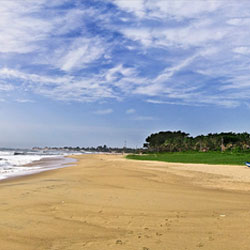
About The Fishermans Cove Temple The Fishermans Cove Temple, located in Chennai, is a beautiful coastal temple dedicated to the goddess Mahishasuramardini, also known as Durga. Situated near the beach, this temple is a popular spot for both tourists and locals alike. The peaceful and serene ambiance of the temple, combined with the sound of the waves crashing against the shore, makes it a perfect place for spiritual worship and relaxation. Architecture of Fishermans Cove Temple The Fishermans Cove Temple is a stunning example of traditional South Indian temple architecture. The temple is adorned with intricate carvings and sculptures of various deities, including Durga, Ganesh, and Shiva. The entrance to the temple is marked by a towering gopuram (gateway tower) intricately decorated with colorful statues and motifs. The sanctum sanctorum houses the idol of goddess Mahishasuramardini, flanked by her divine companions. History The Fishermans Cove Temple has a long and storied history dating back centuries. Legend has it that the temple was built by a group of fisherfolk who were saved from a storm by the grace of goddess Durga. In gratitude, they constructed the temple as a symbol of their devotion. Over the years, the temple has undergone several renovations and additions, but its spiritual significance remains unchanged. Best Time To Visit The Fishermans Cove Temple can be visited throughout the year, but the best time to experience its beauty is during the annual festival of Navratri. During this nine-day celebration, the temple is adorned with colorful decorations, and special prayers and rituals are conducted in honor of goddess Durga. The festive atmosphere, combined with the cool sea breeze, makes Navratri a truly magical time to visit the temple. How To Reach The Fishermans Cove Temple is located in Covelong, a small village near Chennai. It can be easily reached by road from Chennai city, with buses and taxis available for hire. The nearest railway station is in Chennai, and the nearest airport is Chennai International Airport. From there, visitors can take a taxi or bus to reach the temple. Significance Of The Fishermans Cove Temple The Fishermans Cove Temple holds great significance for the local community, as well as for visitors seeking spiritual solace. The temple is believed to be a powerful place of worship where devotees can seek blessings and divine intervention from goddess Durga. Many people visit the temple to offer prayers for health, prosperity, and protection from evil forces. The peaceful and serene environment of the temple, combined with its stunning architecture, makes it a must-visit destination for anyone seeking a spiritual retreat. In conclusion, the Fishermans Cove Temple in Chennai is a beautiful and sacred place that holds deep spiritual significance for many. Its stunning architecture, rich history, and serene ambiance make it a must-visit destination for anyone seeking peace and tranquility. Whether you are a devout worshipper or simply a curious traveler, the Fishermans Cove Temple is sure to leave a lasting impression on your heart and soul.
Explore More
About The Tiruchendur Temple The Tiruchendur Temple, located in Kanyakumari district in the state of Tamil Nadu, is one of the most famous temples dedicated to Lord Murugan. It is situated on the shores of the Bay of Bengal and is considered to be one of the six abodes of Lord Murugan. The temple is known for its stunning architecture, rich history, and spiritual significance. Architecture of Tiruchendur Temple The Tiruchendur Temple is a classic example of Dravidian architecture, characterized by its tall gopurams, intricate carvings, and majestic pillars. The temple complex is spread over a vast area and includes several mandapams, shrines, and tanks. The main sanctum sanctorum houses the idol of Lord Murugan in all his glory, adorned with precious jewels and intricate garments. History The history of the Tiruchendur Temple dates back to ancient times and is shrouded in legends and myths. It is believed that the temple was built by the Pandya kings in the 17th century. Over the centuries, the temple has undergone several renovations and additions, making it the magnificent structure it is today. The temple is also mentioned in various ancient texts and scriptures, highlighting its importance in Hindu mythology. Best Time To Visit The best time to visit the Tiruchendur Temple is during the festival of Skanda Sashti, which is celebrated with great fervor and devotion. The festival typically falls in the Tamil month of Aippasi (October-November) and attracts thousands of pilgrims from all over the country. The temple also sees a surge in visitors during other important festivals such as Thai Poosam and Panguni Uthiram. How To Reach The Tiruchendur Temple is well-connected by road, rail, and air. The nearest airport is located in Madurai, which is around 180 kilometers away from the temple. The nearest railway station is located in Tirunelveli, which is around 40 kilometers away. From these points, one can easily hire a taxi or take a bus to reach the temple. The temple is also easily accessible by private vehicles. Significance Of The Tiruchendur Temple The Tiruchendur Temple holds immense spiritual significance for devotees of Lord Murugan. It is believed that worshipping at this temple can fulfill one's desires, bring prosperity, and remove obstacles from one's life. The temple also offers various rituals and poojas for devotees seeking blessings for their well-being and prosperity. The serene and tranquil atmosphere of the temple makes it an ideal place for meditation and spiritual retreat. In conclusion, the Tiruchendur Temple in Kanyakumari is a place of great beauty, history, and spirituality. It is a must-visit destination for anyone seeking solace, peace, and blessings from the divine. The temple's grand architecture, rich history, and spiritual significance make it a popular pilgrimage site for devotees from all walks of life.
Explore More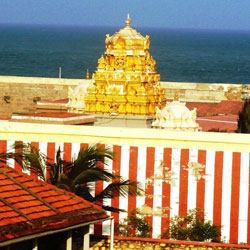
About The Kumari Amman Temple The Kumari Amman Temple, also known as the Kanyakumari Temple, is a renowned Hindu temple dedicated to the goddess Devi Kanya Kumari, believed to be an incarnation of Goddess Parvati. Located in Kanyakumari in the southernmost tip of India, the temple is a significant pilgrimage site for devotees from all over the country. It is also a popular tourist destination due to its serene location by the confluence of the Arabian Sea, Bay of Bengal, and Indian Ocean. Architecture of Kumari Amman Temple The Kumari Amman Temple showcases a unique blend of Dravidian and Kerala architectural styles. The temple complex is adorned with intricate carvings, colorful paintings, and grand sculptures of various Hindu deities. The main shrine of the goddess is situated on a rock overlooking the sea, creating a picturesque setting for worship. History The history of the Kumari Amman Temple dates back to ancient times, with references to the goddess Kanya Kumari found in various Hindu scriptures and legends. According to mythology, the goddess performed severe penance to win Lord Shiva's hand in marriage. However, the wedding did not take place, leading to the formation of the stone idol of the goddess at Kanyakumari. Over the centuries, the temple has undergone several renovations and reconstructions, with the current structure dating back to the 18th century. The temple's rich history and spiritual significance continue to attract pilgrims and tourists alike. Best Time To Visit The best time to visit the Kumari Amman Temple is during the winter months of October to March when the weather is pleasant and conducive for sightseeing. The temple is also bustling with devotees during festivals such as Navratri and Pongal, making it a vibrant and lively atmosphere for visitors. How To Reach Kanyakumari is well-connected by road, rail, and air, making it easily accessible for travelers from all parts of the country. The nearest airport is Trivandrum International Airport, approximately 90 kilometers away. The town also has a railway station with regular trains connecting it to major cities like Chennai, Bangalore, and Mumbai. For those traveling by road, Kanyakumari is well-connected through a network of national highways and state roads. Buses, taxis, and private vehicles are readily available for transportation within the town and to nearby attractions. Significance Of The Kumari Amman Temple The Kumari Amman Temple holds immense significance for devotees, as it is believed to fulfill the wishes of those who visit with a pure heart and devotion. The goddess is worshipped for protection, wisdom, and prosperity, and many rituals and ceremonies are performed to seek her blessings. Aside from its religious importance, the temple also serves as a symbol of unity and harmony, as it attracts people from different faiths and backgrounds. The serene ambiance of the temple, coupled with its breathtaking views of the ocean, create a sense of peace and tranquility for all who visit. Overall, the Kumari Amman Temple is a must-visit destination for those seeking spiritual solace, cultural enrichment, and natural beauty in the enchanting town of Kanyakumari.
Explore More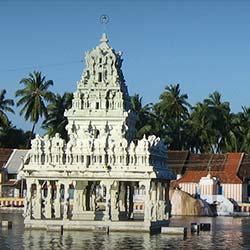
About The Thanumalayan Temple The Thanumalayan Temple, also known as Sthanumalayan Temple, is a famous Hindu temple located in Suchindram, near Kanyakumari in Tamil Nadu, India. This temple is dedicated to the Trimurti - the Hindu trinity of Brahma, Vishnu, and Shiva, represented by three different deities that are worshipped in the same sanctum sanctorum. Architecture of Thanumalayan Temple The architecture of the Thanumalayan Temple is a stunning blend of Dravidian and Kerala styles, showcasing intricate carvings and exquisite sculptures. The temple complex consists of three main structures - the main temple dedicated to the Trimurti, the temple of Goddess Kamakshi, and the temple of Lord Hanuman. The 55-meter-tall gopuram (gateway tower) adorned with colorful sculptures and paintings is a sight to behold. History The Thanumalayan Temple has a rich history dating back to ancient times. It is said to have been built by Maharaja Marthanda Varma of Travancore in the 17th century. The temple has undergone several renovations and expansions over the centuries, each contributing to its grandeur and spiritual significance. The temple continues to be a place of worship and pilgrimage for devotees from far and wide. Best Time To Visit The best time to visit the Thanumalayan Temple is during the winter months of October to March when the weather is pleasant and conducive for sightseeing. The temple also hosts various festivals and religious events during this time, offering visitors a chance to partake in the vibrant cultural celebrations. How To Reach The Thanumalayan Temple is easily accessible by road, rail, and air. The nearest airport is Trivandrum International Airport, located approximately 70 kilometers away. The nearest railway station is Nagercoil Junction, about 13 kilometers from the temple. Buses and taxis are available from Kanyakumari, Nagercoil, and other nearby cities to reach the temple. Significance Of The Thanumalayan Temple The Thanumalayan Temple holds immense significance for devotees and pilgrims, who come to seek the blessings of the Trimurti. The temple is believed to be a sacred site where prayers are answered and wishes are fulfilled. The elaborate rituals and ceremonies performed at the temple create a spiritual ambiance that draws visitors seeking solace, peace, and divine grace. In conclusion, the Thanumalayan Temple in Kanyakumari is not just a place of worship but also a testament to the rich cultural heritage and architectural marvels of South India. Its serene surroundings, majestic structures, and spiritual aura make it a must-visit destination for those seeking a spiritual journey or simply looking to marvel at the beauty of Hindu architecture.
Explore More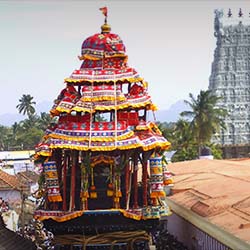
About The Swamithope Pathi Temple The Swamithope Pathi Temple, also known as the Ambalapathi Temple, is a renowned Hindu temple located in the town of Kanyakumari in Tamil Nadu, India. The temple is dedicated to the deity Swami Ayyappan, who is believed to be an incarnation of Lord Dharma Sastha. The temple is considered to be a significant pilgrimage site for followers of the Ayyavazhi faith. Architecture of Swamithope Pathi Temple The Swamithope Pathi Temple is known for its unique architecture, featuring a circular structure with a conical roof. The temple's walls are adorned with intricate carvings depicting various scenes from Hindu mythology. The main sanctum sanctorum houses the idol of Swami Ayyappan, along with other deities such as Lord Shiva and Goddess Parvati. History The Swamithope Pathi Temple has a rich history dating back to the 19th century when it was established by Sri Vaikundar, the founder of the Ayyavazhi faith. The temple is believed to be the birthplace of Swami Ayyappan, and it holds great significance for his followers. Over the years, the temple has become a popular destination for pilgrims seeking blessings and spiritual solace. Best Time To Visit The best time to visit the Swamithope Pathi Temple is during the winter months of November to February when the weather is cool and pleasant. This is also the time when various festivals and rituals are celebrated at the temple, making it a vibrant and lively place to visit. How To Reach The Swamithope Pathi Temple is easily accessible by road, rail, and air. The nearest railway station is Kanyakumari Railway Station, which is well-connected to major cities in India. The temple is also located close to the Kanyakumari Bus Stand, making it convenient for visitors to reach the temple by road. For those traveling by air, the nearest airport is Trivandrum International Airport, which is located approximately 90 kilometers away from the temple. Significance Of The Swamithope Pathi Temple The Swamithope Pathi Temple holds great significance for followers of the Ayyavazhi faith, as it is believed to be the birthplace of Swami Ayyappan. The temple is considered to be a sacred place where devotees come to seek blessings, fulfill their wishes, and offer prayers. The tranquil ambiance of the temple and its beautiful surroundings make it a peaceful retreat for those seeking spiritual enlightenment. Overall, the Swamithope Pathi Temple is a place of great devotion and tranquility, where visitors can experience a sense of peace and serenity amidst its beautiful surroundings.
Explore More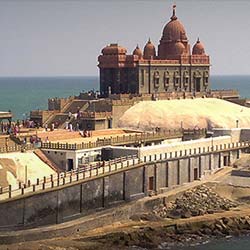
About The Kanyakumari Temple The Kanyakumari Temple, also known as the Kumari Amman Temple, is a renowned Hindu temple located in Kanyakumari, Tamil Nadu. It is dedicated to the goddess Devi Kanya Kumari, who is believed to be the virgin goddess and the protector of the region. The temple is located at the southernmost tip of the Indian subcontinent, where the Bay of Bengal, the Arabian Sea, and the Indian Ocean meet. It is a popular pilgrimage site for devotees from all over the country. Architecture of Kanyakumari Temple The Kanyakumari Temple is known for its stunning architecture and intricate carvings. The temple is built in the Dravidian style of architecture, with a towering gopuram (gateway tower) that is adorned with colorful sculptures of gods and goddesses. The inner sanctum of the temple houses the idol of Devi Kanya Kumari, which is adorned with jewels and flowers. The temple complex also includes various other shrines dedicated to different deities. History The history of the Kanyakumari Temple dates back to ancient times. It is believed that the temple was originally built by the Pandyan kings in the 8th century. Over the centuries, the temple has been renovated and expanded by various rulers, including the Chola and Nayaka dynasties. The temple has a rich historical significance and is considered to be one of the holiest sites in South India. Best Time To Visit The best time to visit the Kanyakumari Temple is during the winter months, from October to March, when the weather is pleasant and conducive for sightseeing and temple visits. The temple is also crowded during festivals and auspicious days, such as Navratri and Pongal. It is advisable to check the temple's schedule before planning your visit to avoid any inconvenience. How To Reach Kanyakumari is well-connected by road, rail, and air. The nearest airport is Trivandrum International Airport, which is located approximately 90 kilometers away. The town has its own railway station, which is connected to major cities like Chennai, Bangalore, and Mumbai. One can also reach Kanyakumari by road through state transport buses or private cabs. Once in Kanyakumari, the temple is easily accessible by foot or local transport. Significance Of The Kanyakumari Temple The Kanyakumari Temple holds immense significance for devotees and pilgrims. It is believed that worshiping Devi Kanya Kumari can help overcome obstacles and fulfill one's desires. The temple is also associated with various legends and myths, including the tale of the goddess slaying a demon to protect the town. The temple's location at the confluence of the seas is considered to be a sacred spot for spiritual enlightenment and meditation. Thousands of devotees flock to the temple every year to seek the blessings of the goddess and experience the divine aura of the place. Overall, the Kanyakumari Temple is a must-visit destination for those seeking spiritual solace and cultural immersion in the vibrant land of Tamil Nadu.
Explore More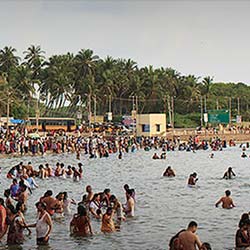
About The Agni Tirtham Temple The Agni Tirtham Temple, located in the sacred town of Rameswaram in Tamil Nadu, is one of the most revered temples in South India. It is dedicated to Lord Shiva and is known for its unique architecture and spiritual significance. The temple is situated on the shores of the Bay of Bengal, providing devotees with a serene and picturesque setting for their prayers and rituals. Architecture of Agni Tirtham Temple The Agni Tirtham Temple is an architectural marvel, showcasing a blend of Dravidian and traditional South Indian temple styles. The temple complex is characterized by its towering gopurams (entrance gates), intricately carved pillars, and ornate sculptures depicting various mythological stories. The sanctum sanctorum houses a sacred lingam, the phallic symbol of Lord Shiva, which is worshipped by devotees from all over the country. History The history of the Agni Tirtham Temple dates back to ancient times, with references to the temple found in the Hindu epic Ramayana. It is believed that Lord Rama, along with his wife Sita and brother Lakshmana, visited Rameswaram on their way back to Ayodhya after defeating the demon king Ravana. The temple is said to have been established by Lord Rama himself as a way to seek atonement for the sin of killing Ravana, who was a Brahmin. Best Time To Visit The best time to visit the Agni Tirtham Temple is during the winter months, from October to March, when the weather is pleasant and conducive for temple visits and rituals. This period also coincides with various festivals and events celebrated at the temple, such as Maha Shivaratri and Thaipusam, which attract a large number of devotees and tourists. How To Reach The Agni Tirtham Temple is easily accessible by road, rail, and air. The nearest airport is in Madurai, located about 170 kilometers away, while the Rameswaram Railway Station connects the town to major cities in Tamil Nadu. Visitors can also opt for bus services or hire taxis from nearby towns like Madurai and Chennai to reach Rameswaram and the temple. Significance Of The Agni Tirtham Temple The Agni Tirtham Temple holds immense spiritual significance for devotees, who believe that taking a holy dip in the sacred waters of the Bay of Bengal near the temple can cleanse them of their sins and bring blessings from the gods. The temple is also famous for its annual Agni Theertham festival, during which thousands of pilgrims gather to participate in rituals and prayers to seek divine blessings and fulfillment of their wishes. In conclusion, the Agni Tirtham Temple in Rameswaram is a place of great religious and cultural importance, attracting devotees and tourists from all over the world. With its beautiful architecture, rich history, and spiritual significance, it continues to be a symbol of devotion and faith for millions of people who visit it every year.
Explore More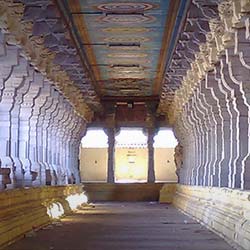
The Ramarokha Temple, located in Rameswaram, is a sacred place of worship dedicated to Lord Rama. The temple holds immense significance for devotees and tourists alike due to its rich history and unique architecture. Let's delve deeper into the details of this ancient temple. About The Ramarokha Temple in Rameswaram The Ramarokha Temple, also known as the Ramakrishna Temple, is situated in the coastal town of Rameswaram in Tamil Nadu. It is believed to be one of the oldest temples in the region, dating back centuries. The temple is dedicated to Lord Rama, who is revered as an incarnation of the Hindu god Vishnu. The name "Ramarokha" translates to "the abode of Lord Rama," signifying the temple's primary deity. Devotees flock to this temple to seek blessings, offer prayers, and immerse themselves in spiritual serenity. Architecture of Ramarokha Temple The architecture of the Ramarokha Temple is a fascinating blend of Dravidian and Rajput styles. The temple's exterior is adorned with intricate carvings, ornate pillars, and colorful sculptures depicting scenes from Hindu mythology. The towering gopuram (entrance tower) welcomes visitors with its intricate designs and vibrant hues. The sanctum sanctorum houses the idol of Lord Rama along with Goddess Sita and Lord Lakshmana. The temple's inner sanctum exudes a sense of peace and tranquility, inviting devotees to offer their prayers and seek divine blessings. History The Ramarokha Temple has a long and storied history that dates back to ancient times. Legend has it that Lord Rama himself visited Rameswaram during his exile and consecrated a lingam at the site where the temple now stands. Over the centuries, the temple underwent several renovations and additions, each contributing to its unique architectural style and spiritual significance. The temple's history is intertwined with various mythological stories and religious beliefs, making it a revered place of worship for generations of devotees. Best Time To Visit The best time to visit the Ramarokha Temple is during the annual festivals and celebrations that take place in Rameswaram. The temple comes alive with vibrant colors, elaborate decorations, and devotional music during these festive occasions. The most popular festival celebrated at the temple is Ram Navami, which commemorates the birth of Lord Rama. Devotees from far and wide gather at the temple to participate in the festivities and seek the blessings of the divine. Visiting the temple during these auspicious times allows visitors to experience the cultural richness and spiritual fervor of Rameswaram. How To Reach Rameswaram is well connected to major cities in Tamil Nadu and other parts of India by road, rail, and air. The nearest airport to Rameswaram is located in Madurai, approximately 174 kilometers away. Visitors can also reach Rameswaram by train, with the Rameswaram Railway Station being the closest railhead. Additionally, state-run buses and private taxis are available for those traveling by road. Once in Rameswaram, the Ramarokha Temple is easily accessible by local transport or on foot from the town center. Significance Of The Ramarokha Temple The Ramarokha Temple holds immense significance for devotees and pilgrims due to its association with Lord Rama and the epic Ramayana. The temple is believed to be a place of divine energy and spiritual power, where devotees can seek blessings, offer prayers, and find solace. The temple's sanctity and historical importance draw visitors from all walks of life, making it a must-visit destination for those seeking spiritual enlightenment and cultural enrichment. The Ramarokha Temple stands as a symbol of faith, devotion, and reverence for Lord Rama, embodying the essence of Hindu spirituality and tradition. In conclusion, the Ramarokha Temple in Rameswaram is a place of profound significance and beauty, steeped in history and religious fervor. Its unique architecture, rich history, and spiritual aura make it a must-visit destination for anyone seeking a spiritual retreat or cultural experience. Plan your trip to Rameswaram and immerse yourself in the divine atmosphere of the Ramarokha Temple, where the blessings of Lord Rama await you.
Explore More7N Alleppey - Kovalam - Kanyakumari - Rameswaram - Madurai Tour
8 Days/ 7 Night
Kovalam - Alleppey - Kanyakumari - Madurai - Rameshwaram
7N Munnar - Madurai - Rameswaram - Kanyakumari - Alleppey Tour
8 Days/ 7 Night
Alleppey - Kanyakumari - Madurai - Rameshwaram - Munnar
Mysore - Ooty And Kodaikanal Tour Package 5N - 6D
6 Days/ 5 Night
Mysore - Coonoor - Kodaikanal - Ooty
Ooty And Coorg Tour Package 4N - 5D
5 Days/ 4 Night
Coorg - Ooty

About The Badrakaliamman Temple The Badrakaliamman Temple is a famous Hindu temple located in Rameswaram, Tamil Nadu. The temple is dedicated to Goddess Badrakaliamman, who is believed to be a fierce form of the goddess Kali. The temple is one of the prominent religious sites in Rameswaram and attracts devotees from far and wide. Architecture of Badrakaliamman Temple The Badrakaliamman Temple boasts of a unique Dravidian style of architecture. The temple complex is adorned with intricate carvings and sculptures that depict various mythological stories. The main sanctum of the temple houses the idol of Goddess Badrakaliamman, who is depicted with multiple arms and a fierce expression. The temple also has smaller shrines dedicated to other deities like Lord Ganesha and Lord Murugan. History The history of the Badrakaliamman Temple dates back several centuries. It is believed that the temple was built by the rulers of the Sethupathi dynasty. The temple has undergone several renovations and expansions over the years, but it has retained its ancient charm and spiritual significance. The temple has been a place of worship and pilgrimage for generations of devotees who seek the blessings of Goddess Badrakaliamman. Best Time To Visit The best time to visit the Badrakaliamman Temple is during the festival of Navratri, which is dedicated to the worship of the goddess Durga. The temple is beautifully decorated during this time, and special rituals and ceremonies are performed to honor the goddess. The festival usually falls in the months of September or October and is a great time to witness the vibrant culture and traditions of Rameswaram. How To Reach The Badrakaliamman Temple is easily accessible by road and is located in the heart of Rameswaram. The nearest airport is in Madurai, which is about 170 kilometers away from Rameswaram. The temple is also well-connected by rail, with regular trains running from major cities like Chennai and Coimbatore. Visitors can also hire private taxis or take local buses to reach the temple. Significance Of The Badrakaliamman Temple The Badrakaliamman Temple holds immense significance for the devotees who believe in the power and blessings of Goddess Badrakaliamman. It is believed that worshipping the goddess at this temple can help overcome obstacles and bring prosperity and peace in one's life. The temple is a place of solace and spiritual rejuvenation for many devotees who come seeking the divine blessings of the goddess. Overall, the Badrakaliamman Temple in Rameswaram is a sacred place that exudes a sense of peace and tranquility. Its rich history, beautiful architecture, and spiritual significance make it a must-visit destination for those seeking a divine experience in the holy town of Rameswaram.
Explore More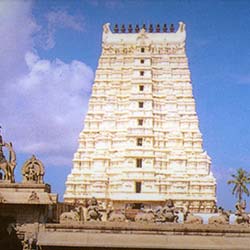
About The Five-faced Hanuman Temple in Rameswaram The Five-faced Hanuman Temple in Rameswaram is a popular pilgrimage site dedicated to Lord Hanuman, one of the most revered Hindu gods. The temple is known for its unique five-faced idol of Lord Hanuman, each face representing a different emotion - love, devotion, courage, peace, and wisdom. It is believed that worshipping Lord Hanuman at this temple can help devotees overcome obstacles and attain spiritual well-being. Architecture of Five-faced Hanuman Temple The architecture of the Five-faced Hanuman Temple is a blend of traditional Dravidian and contemporary styles. The temple has a grand entrance with intricate carvings and sculptures depicting scenes from the Ramayana, the epic that narrates the life of Lord Rama. The sanctum sanctorum houses the five-faced idol of Lord Hanuman, which is made of Panchaloha (a mix of five metals). History The Five-faced Hanuman Temple has a rich history dating back several centuries. According to legend, the temple was built by a devout king who had a vision of Lord Hanuman with five faces. The king then commissioned the construction of the temple to honor the deity. Over the years, the temple has undergone several renovations and expansions, but its sanctity and spiritual significance have remained unchanged. Best Time To Visit The best time to visit the Five-faced Hanuman Temple in Rameswaram is during the festive season, especially on Hanuman Jayanti (the birthday of Lord Hanuman) and Diwali. During these times, the temple is adorned with colorful decorations and lights, and devotees from far and wide gather to offer their prayers and seek blessings. It is recommended to visit the temple in the early morning or evening to avoid crowds and experience a peaceful darshan. How To Reach The Five-faced Hanuman Temple is located in Rameswaram, a holy town in Tamil Nadu. The nearest airport is in Madurai, approximately 180 kilometers away, and the nearest railway station is in Rameswaram itself. From Madurai, one can hire a taxi or take a bus to reach Rameswaram. Once in Rameswaram, the temple is easily accessible by local transportation or on foot. Significance Of The Five-faced Hanuman Temple The Five-faced Hanuman Temple holds great significance for devotees who believe in the power and blessings of Lord Hanuman. It is said that worshipping the five-faced idol of Lord Hanuman can help one overcome fear, negativity, and obstacles in life. The temple is also known for its healing powers, and many devotees visit it seeking relief from physical and emotional ailments. Overall, the Five-faced Hanuman Temple is a sacred place where one can find solace, strength, and spiritual guidance.
Explore More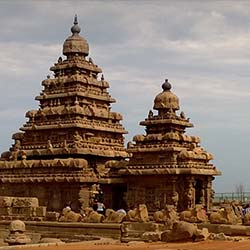
About The Shore Temple in Mahabalipuram The Shore Temple is a famous historic temple located in Mahabalipuram, a coastal town in the southern state of Tamil Nadu, India. This ancient temple is a UNESCO World Heritage Site and is renowned for its architectural grandeur and historical significance. Architecture of Shore Temple The Shore Temple is a masterpiece of Dravidian architecture dating back to the 8th century AD. It is made entirely of granite and stands as a testimony to the architectural skills of the Pallava dynasty. The temple complex consists of three shrines dedicated to Lord Shiva and Lord Vishnu, with the main shrine dedicated to Lord Shiva. The temple is surrounded by beautifully carved sculptures depicting various Hindu deities, mythical creatures, and scenes from Hindu mythology. The intricate carvings on the walls and pillars of the temple are a sight to behold. History The Shore Temple was constructed by the Pallava dynasty during the reign of Rajasimha (Narasimhavarman II) in the 8th century AD. The temple was built to commemorate the maritime success of the Pallava dynasty and is believed to have served as a beacon for sailors navigating the Bay of Bengal. Over the centuries, the temple suffered damage due to natural disasters and erosion caused by the sea. However, efforts have been made to preserve and restore this ancient marvel, making it one of the most visited tourist attractions in Tamil Nadu. Best Time To Visit The best time to visit the Shore Temple is during the winter months from November to February when the weather is pleasant and ideal for exploring the temple complex. The temple looks particularly enchanting during sunrise and sunset when the golden rays of the sun illuminate the ancient stone structures. How To Reach The Shore Temple is located in Mahabalipuram, approximately 60 kilometers from the city of Chennai. The nearest airport is Chennai International Airport, which is well-connected to major cities in India and abroad. From Chennai, visitors can hire a taxi or take a bus to reach Mahabalipuram. The town is also well-connected by road and rail, making it easily accessible for tourists. Significance Of The Shore Temple The Shore Temple holds immense historical and religious significance for the people of Tamil Nadu. It is considered a sacred pilgrimage site for devotees of Lord Shiva and Lord Vishnu. The temple complex is a living testament to the rich cultural heritage of India and is a symbol of the architectural excellence of the Pallava dynasty. The Shore Temple is not just a place of worship but also a window to the past, offering visitors a glimpse into the glorious history of ancient India. Visitors to the Shore Temple are mesmerized by its beauty, serenity, and timeless charm. The temple remains a popular destination for tourists, history buffs, and spiritual seekers alike, drawing visitors from all over the world to marvel at its grandeur and soak in the spiritual aura of this ancient site.
Explore More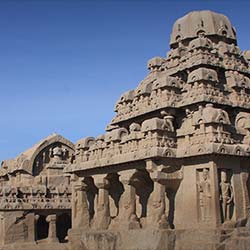
About The Pancha Ratha Temple The Pancha Ratha Temple is a unique architectural marvel located in Mahabalipuram, Tamil Nadu. This temple complex is a UNESCO World Heritage Site and is renowned for its exquisite rock-cut sculptures and intricate carvings. The term "Pancha Ratha" translates to "Five Chariots" in English, as each of the structures within the complex resembles a chariot. The Pancha Ratha Temple is a fine example of Dravidian architecture and dates back to the 7th century. Architecture of Pancha Ratha Temple The Pancha Ratha Temple is a representation of the diverse styles of South Indian temple architecture. Each of the five shrines within the complex is dedicated to a different deity from Hindu mythology, including Lord Shiva, Lord Vishnu, and Goddess Durga. The temples are monolithic, meaning they were carved out of a single rock formation. The intricate carvings on the walls depict various mythological scenes, gods, goddesses, and animals. The Pancha Ratha Temple complex is a blend of both Dravidian and Buddhist architectural styles. The structures are adorned with intricate sculptures of lions, elephants, mythical creatures, and gods and goddesses. The temple complex is a testament to the skill and craftsmanship of the artisans who built it. History The Pancha Ratha Temple was built during the reign of the Pallava dynasty in the 7th century. The Pallavas were known for their patronage of art and architecture, and the Pancha Ratha Temple is a fine example of their architectural prowess. The temple complex was likely built as a dedication to the Pandavas, the heroes of the Indian epic Mahabharata. Over the centuries, the Pancha Ratha Temple complex fell into disrepair and was eventually abandoned. It was rediscovered by British archaeologists in the 19th century, and efforts were made to restore and preserve the site. Today, the Pancha Ratha Temple is a popular tourist destination and a testament to India's rich cultural heritage. Best Time To Visit The best time to visit the Pancha Ratha Temple is during the winter months, from November to February. The weather is pleasant during this time, making it ideal for exploring the temple complex. The temperatures in Mahabalipuram can be quite hot and humid during the summer months, so visiting in the winter ensures a more comfortable experience. How To Reach The Pancha Ratha Temple is located in Mahabalipuram, Tamil Nadu, which is well-connected by road and rail. The nearest airport is Chennai International Airport, which is approximately 60 kilometers away. From Chennai, visitors can take a bus or hire a taxi to reach Mahabalipuram. The temple complex is easily accessible by road, and there are plenty of transportation options available for visitors. Significance Of The Pancha Ratha Temple The Pancha Ratha Temple is of great cultural and historical significance. It is a prime example of ancient Indian temple architecture and showcases the skill and craftsmanship of the artisans of the Pallava dynasty. The temple complex is a UNESCO World Heritage Site and attracts visitors from around the world who come to admire its beauty and architectural splendor. Visiting the Pancha Ratha Temple is a unique experience that offers a glimpse into India's rich cultural and architectural heritage. The intricate carvings, beautiful sculptures, and serene surroundings make it a must-visit destination for history buffs, art enthusiasts, and spiritual seekers alike.
Explore More
About The Varaha Cave Temple The Varaha Cave Temple is a rock-cut cave temple located in Mahabalipuram, Tamil Nadu, India. It is one of the most important monuments in the town and is a significant example of Indian rock-cut architecture. The temple is dedicated to Lord Vishnu in his Varaha avatar, which is depicted as a boar lifting the Earth goddess, Bhudevi, from the cosmic ocean. Architecture of Varaha Cave Temple The Varaha Cave Temple is a monolithic rock-cut structure carved directly into a granite cliff. The facade of the temple features intricate carvings of mythical creatures, gods, and goddesses. The main chamber of the temple is supported by eight columns with various carvings on them. The central shrine houses a magnificent sculpture of Lord Vishnu in his Varaha avatar. The entire temple is adorned with beautiful carvings and sculptures that showcase the skill and craftsmanship of the artisans of that era. History The Varaha Cave Temple was built during the 7th century by the Pallava dynasty, who were known for their patronage of art and architecture. The Pallavas were great builders and left behind many magnificent monuments in Mahabalipuram, including the Varaha Cave Temple. The temple is believed to have been used for worship by the Pallava kings and their subjects, as well as for various religious ceremonies and rituals. Best Time To Visit The best time to visit the Varaha Cave Temple is during the winter months, from November to February, when the weather is pleasant and cool. It is advisable to visit early in the morning or late in the evening to avoid the heat and crowds. The temple is open to visitors every day from sunrise to sunset, and the entry fee is nominal. How To Reach The Varaha Cave Temple is located in Mahabalipuram, which is well-connected by road and rail. The nearest airport is Chennai International Airport, which is about 60 kilometers away from Mahabalipuram. From Chennai, you can hire a taxi or take a bus to reach Mahabalipuram. The temple is easily accessible by road, and you can also hire a local auto-rickshaw to reach the temple from the town center. Significance Of The Varaha Cave Temple The Varaha Cave Temple is of great significance to devotees of Lord Vishnu and is considered a sacred site for Hindus. The temple is not only a place of worship but also a fine example of ancient Indian rock-cut architecture. It is a testament to the skill and craftsmanship of the artisans of the Pallava dynasty, who created such magnificent structures out of solid rock. The temple's intricate carvings and sculptures depict various scenes from Hindu mythology and provide a glimpse into the rich cultural heritage of India. Visiting the Varaha Cave Temple is not only a spiritual experience but also an opportunity to admire the beauty and artistry of ancient Indian architecture.
Explore More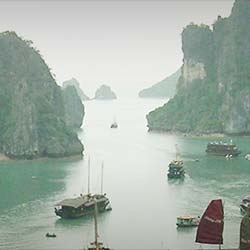
About The Sthala Sayana Perumal Temple The Sthala Sayana Perumal Temple, located in Mahabalipuram, is a famous Hindu temple dedicated to Lord Vishnu. It is one of the 108 Divya Desams, which are sacred temples dedicated to Lord Vishnu and praised by the Alvars, a group of Tamil poet-saints. The temple is known for its historical significance, beautiful architecture, and religious importance. Architecture of Sthala Sayana Perumal Temple The Sthala Sayana Perumal Temple features typical Dravidian architecture with intricate carvings and sculptures. The temple complex consists of a main shrine dedicated to Lord Vishnu in a reclining posture known as Sayana Kolam. The deity is depicted in a serene and peaceful state, lying on a snake bed with a canopy of seven serpent hoods. The entrance of the temple is adorned with beautifully carved pillars and intricate sculptures of various deities. The main sanctum sanctorum houses the idol of Lord Vishnu along with Goddess Lakshmi, his consort. The temple also has several smaller shrines dedicated to other gods and goddesses. The temple tank, known as Karunya Pushkarini, adds to the beauty of the temple complex. It is believed that taking a dip in the sacred waters of the tank can cleanse one's sins and bestow blessings. History The Sthala Sayana Perumal Temple has a rich history dating back to the Pallava dynasty in the 8th century. The temple was built by Narasimhavarman II, also known as Rajasimha, who was a great patron of art and architecture. The temple has undergone several renovations and additions over the centuries, reflecting the architectural styles of different periods. The temple is mentioned in ancient Tamil texts and inscriptions, highlighting its importance as a place of worship and pilgrimage. The temple's historical significance and religious importance make it a popular destination for devotees and tourists alike. Best Time To Visit The best time to visit the Sthala Sayana Perumal Temple is during the winter months, from November to February, when the weather is pleasant and conducive for sightseeing. The temple is less crowded during this time, allowing visitors to explore the intricate carvings and sculptures at their own pace. Another auspicious time to visit the temple is during festivals and special occasions dedicated to Lord Vishnu, such as Vaikuntha Ekadashi and Brahmotsavam. These festivals are celebrated with great fervor and attract a large number of devotees from far and wide. How To Reach The Sthala Sayana Perumal Temple is located in Mahabalipuram, a popular tourist destination in Tamil Nadu. The nearest airport is Chennai International Airport, which is well-connected to major cities in India and abroad. From the airport, visitors can hire a taxi or take a bus to reach Mahabalipuram. The temple is easily accessible by road and is well-connected to nearby towns and cities. Buses and taxis are available for local transportation within Mahabalipuram. Visitors can also hire auto-rickshaws or bicycles to explore the town and visit the temple. Significance Of The Sthala Sayana Perumal Temple The Sthala Sayana Perumal Temple holds great significance for devotees of Lord Vishnu. The reclining posture of Lord Vishnu symbolizes his cosmic sleep, representing the cycle of creation, preservation, and destruction. The temple's sanctum sanctorum is a place of peace and tranquility, where devotees can seek blessings and solace. The temple is also associated with various legends and myths that highlight the glory and greatness of Lord Vishnu. It is believed that worshipping at the temple can fulfill one's wishes and bring prosperity and happiness. Overall, the Sthala Sayana Perumal Temple is a sacred place of worship, architectural marvel, and cultural heritage that continues to attract devotees and visitors from all walks of life.
Explore More
About The Olakkannesvara Temple The Olakkannesvara Temple, located in Mahabalipuram, is a significant Hindu temple dedicated to Lord Shiva. This ancient temple is known for its unique architecture, historical significance, and spiritual importance. The temple is a popular pilgrimage site for devotees and a must-visit for tourists exploring the rich cultural heritage of Tamil Nadu. Architecture of Olakkannesvara Temple The Olakkannesvara Temple showcases exquisite Dravidian style architecture, characterized by its intricate carvings, towering gopurams (gateway towers), and ornate pillars. The temple complex features a main sanctum dedicated to Lord Shiva, surrounded by smaller shrines dedicated to various deities. The outer walls of the temple are adorned with detailed sculptures depicting scenes from Hindu mythology, celestial beings, and intricate motifs. The temple's main entrance, known as the Mahadwaram, is a grand structure decorated with elaborate carvings and sculptures. The inner sanctum houses a Shiva Lingam, the sacred symbol of Lord Shiva, worshipped by devotees. The temple's architecture reflects the craftsmanship and artistic skills of the ancient builders who constructed this magnificent shrine. History The Olakkannesvara Temple has a rich history that dates back to the Pallava dynasty, which ruled the region in the 7th century. The temple was built during the reign of King Narasimhavarman II, also known as Rajasimha, a prominent Pallava ruler known for his patronage of the arts and architecture. The temple served as a center of worship and cultural activities during the Pallava period, attracting pilgrims and scholars from far and wide. Over the centuries, the temple underwent several renovations and additions, with each ruler leaving their mark on the structure. The intricate carvings and sculptures found in the temple are a testament to the skilled craftsmanship and artistic vision of the Pallava artisans who worked on its construction. Best Time To Visit The best time to visit the Olakkannesvara Temple is during the winter months, from November to February, when the weather is pleasant and ideal for exploring the temple complex. The annual festival of Maha Shivaratri, celebrated in honor of Lord Shiva, is a special time to visit the temple, as it is adorned with lights, decorations, and a festive atmosphere. Visitors can witness traditional rituals, cultural performances, and spiritual discourses during this auspicious occasion. It is advisable to avoid visiting the temple during the monsoon season, from June to September, as heavy rainfall can disrupt travel plans and make it difficult to explore the temple premises comfortably. How To Reach The Olakkannesvara Temple is located in Mahabalipuram, a coastal town in Tamil Nadu, known for its ancient temples and rock-cut monuments. The nearest airport is Chennai International Airport, approximately 60 kilometers away, which is well-connected to major cities in India and abroad. Visitors can hire a taxi or take a bus from Chennai to reach Mahabalipuram. For those traveling by train, the nearest railway station is Chengalpattu, around 29 kilometers from Mahabalipuram. From Chengalpattu, visitors can hire a taxi or take a bus to reach the temple. The town of Mahabalipuram is well-connected by road, and buses and taxis are easily available for local transportation. Significance Of The Olakkannesvara Temple The Olakkannesvara Temple holds immense religious significance for followers of Hinduism, especially devotees of Lord Shiva. The temple is revered as a sacred site where devotees come to seek blessings, offer prayers, and participate in religious ceremonies. The spiritual ambiance of the temple, coupled with its historical importance, makes it a popular destination for pilgrims and tourists alike. The temple complex also serves as a cultural heritage site, showcasing the architectural brilliance and artistic achievements of the Pallava civilization. The intricate carvings, sculptures, and ornate decorations found in the temple are a visual delight for art enthusiasts and history buffs, offering a glimpse into the rich cultural heritage of Tamil Nadu. Visiting the Olakkannesvara Temple is not only a religious experience but also an opportunity to immerse oneself in the ancient traditions and architectural wonders of South India. The temple stands as a testimony to the glory of the Pallava dynasty and their contribution to the art and culture of the region. Overall, the Olakkannesvara Temple is a must-visit destination for those seeking spiritual solace, cultural enlightenment, and a deeper appreciation for India's rich heritage.
Explore More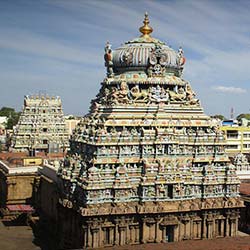
About The Koodal Azhagar Temple The Koodal Azhagar Temple, located in Madurai, Tamil Nadu, is a renowned Hindu temple dedicated to Lord Vishnu. The temple is one of the 108 Divya Desams, which are sacred shrines dedicated to Lord Vishnu mentioned in the works of the Alvars, prominent Tamil poet-saints. The temple is also known as Koodal Alagar Temple and is a significant pilgrimage site for Vaishnavites. The presiding deity of the Koodal Azhagar Temple is Lord Vishnu in his Koodal Azhagar form, which means "beautiful bridegroom" in Tamil. The deity is depicted in a standing posture with a conch and a discus in his hands. The temple also houses shrines dedicated to Goddess Lakshmi, Andal, Garuda, and Hanuman. Architecture of Koodal Azhagar Temple The Koodal Azhagar Temple showcases a unique blend of Dravidian and Vijayanagara architectural styles. The temple complex is characterized by intricately carved pillars, gopurams (gateway towers), and mandapams (halls). The main shrine of Lord Koodal Azhagar is adorned with exquisite sculptures and paintings that depict various episodes from Hindu mythology. The temple also features a sacred tank called Alwar Thirunagari, where devotees can take a holy dip before offering their prayers. The temple premises are surrounded by lush gardens and ancient trees, creating a serene and peaceful atmosphere for spiritual contemplation. History The Koodal Azhagar Temple has a rich historical significance dating back to the Sangam period. Legends suggest that the temple was built by the Pandyan kings and later renovated by various rulers, including the Nayaks and the Vijayanagara kings. The temple complex has undergone several expansions and renovations over the centuries, resulting in its present grandeur. The temple is also associated with the Azhagar Kovil festival, a grand annual celebration where Lord Koodal Azhagar is taken in a procession to the Azhagar Kovil in the nearby Alagar Hills. The festival attracts thousands of devotees who come to witness the divine procession and seek the blessings of the deity. Best Time To Visit The best time to visit the Koodal Azhagar Temple is during the Tamil months of Chittirai (April-May) and Panguni (March-April) when major festivals like Panguni Uthiram and Azhagar Kovil festival are celebrated with great pomp and gaiety. These festive occasions offer a unique opportunity to witness the temple adorned with colorful decorations, music, and dance performances. Visitors can also explore the temple during the early morning or evening hours to experience the divine ambience and participate in the daily rituals and prayers conducted by the temple priests. How To Reach The Koodal Azhagar Temple is easily accessible from Madurai city and is located at a distance of about 2 km from the Meenakshi Amman Temple. Visitors can reach the temple by road, as it is well-connected by local buses, taxis, and auto-rickshaws. The nearest railway station is Madurai Junction, which is about 3 km away from the temple. For those arriving by air, Madurai Airport is the nearest airport, located approximately 12 km away from the temple. From the airport, visitors can hire a taxi or take a bus to reach the Koodal Azhagar Temple. Significance Of The Koodal Azhagar Temple The Koodal Azhagar Temple holds immense spiritual significance for devotees who believe that seeking the blessings of Lord Koodal Azhagar can bring prosperity, peace, and fulfillment in their lives. The temple is also revered for its architectural beauty, historical importance, and cultural heritage, making it a must-visit destination for tourists and pilgrims alike. Devotees often offer prayers, perform rituals, and participate in religious ceremonies to express their devotion and seek divine intervention in their lives. The serene surroundings, sacred atmosphere, and ancient traditions associated with the Koodal Azhagar Temple create a sense of spiritual upliftment and inner peace for all who visit this sacred place. Overall, the Koodal Azhagar Temple stands as a symbol of faith, devotion, and cultural heritage, attracting visitors from far and wide to experience the divine blessings and spiritual aura of this sacred shrine dedicated to Lord Vishnu.
Explore More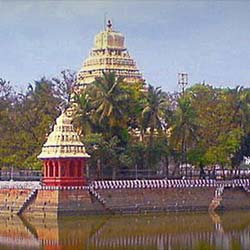
About The Vandiyur Mariamman Teppakulam Temple The Vandiyur Mariamman Teppakulam Temple is a historic temple located in Madurai, Tamil Nadu. The temple is dedicated to Goddess Mariamman, who is believed to be the protector of the city. One of the main attractions of the temple is the Teppakulam, a large tank spread across 16 acres, which is used for the annual float festival. Architecture of Vandiyur Mariamman Teppakulam Temple The temple boasts of magnificent Dravidian architecture, with intricate carvings and sculptures that adorn the walls. The main shrine of the temple is dedicated to Goddess Mariamman, while there are separate shrines for Lord Ganesh, Lord Murugan, and Lord Shiva. The Teppakulam is surrounded by a mandapam with steps leading down to the tank, where the float festival takes place. History The Vandiyur Mariamman Teppakulam Temple has a rich history that dates back to the 17th century. The tank was built by King Thirumalai Nayak, the ruler of Madurai, as a part of his grand architectural vision for the city. The temple has since been renovated and expanded by various rulers, making it a significant landmark in Madurai. Best Time To Visit The best time to visit the Vandiyur Mariamman Teppakulam Temple is during the annual float festival, which usually takes place in the month of January or February. The festival is a grand celebration where the deities are taken out on a beautifully decorated float and paraded around the tank. The temple is also a popular destination during Navratri, a nine-day festival dedicated to Goddess Mariamman. How To Reach The Vandiyur Mariamman Teppakulam Temple is located in the heart of Madurai and is easily accessible by road. The nearest railway station is Madurai Junction, which is well-connected to major cities in Tamil Nadu. The temple is also a short drive from the Madurai Airport, which has regular flights to cities like Chennai and Bangalore. Significance Of The Vandiyur Mariamman Teppakulam Temple The Vandiyur Mariamman Teppakulam Temple holds a special place in the hearts of the people of Madurai. It is believed that praying to Goddess Mariamman at this temple can bring blessings of health and prosperity. The float festival is a symbol of unity and devotion, as people from all walks of life come together to celebrate the goddess and seek her blessings. In conclusion, the Vandiyur Mariamman Teppakulam Temple is not just a place of worship, but a cultural and architectural marvel that reflects the rich history of Madurai. The temple's stunning architecture, rich history, and cultural significance make it a must-visit destination for anyone interested in exploring the heritage of Tamil Nadu.
Explore More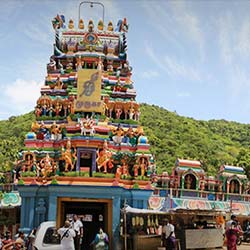
About The Pazhamudhir Solai Temple The Pazhamudhir Solai Temple is a renowned Hindu temple located near Madurai in Tamil Nadu, India. This temple is dedicated to Lord Subramanya, also known as Lord Murugan, who is worshipped as the God of War and Victory. The temple is situated amidst lush greenery and is surrounded by hills, making it a serene and tranquil place for devotees to visit and seek blessings. Architecture of Pazhamudhir Solai Temple The Pazhamudhir Solai Temple is known for its exquisite Dravidian-style architecture. The temple complex is adorned with intricate carvings and sculptures that depict various scenes from Hindu mythology. The main shrine of Lord Subramanya is made of stone and is designed in a traditional South Indian architectural style. The temple also features a beautiful gopuram (gateway tower) that is a sight to behold. History The Pazhamudhir Solai Temple has a rich history that dates back several centuries. It is believed that the temple was built during the Pandya dynasty's rule in the region. The temple has been mentioned in ancient Tamil texts and is considered to be a sacred site by devotees. Over the years, the temple has undergone several renovations and additions, but its spiritual significance has remained unchanged. Best Time To Visit The best time to visit the Pazhamudhir Solai Temple is during the winter months of November to February when the weather is pleasant and ideal for exploring the temple complex. Additionally, the temple hosts several festivals and events during this time, making it a vibrant and festive atmosphere that attracts devotees from far and wide. How To Reach The Pazhamudhir Solai Temple is located approximately 25 kilometers from Madurai city in Tamil Nadu. The nearest airport is Madurai Airport, which is well-connected to major cities in India. Visitors can also reach the temple by road via buses or taxis from Madurai. The temple is located amidst scenic surroundings, making the journey to the temple a memorable experience. Significance Of The Pazhamudhir Solai Temple The Pazhamudhir Solai Temple holds great significance for devotees of Lord Subramanya. It is believed that worshipping at this temple can bring success, prosperity, and protection from evil forces. The temple is also known for its healing powers, and many devotees offer prayers here for good health and well-being. The serene atmosphere of the temple and the spiritual energy it exudes make it a popular pilgrimage site for devotees seeking blessings from the divine. In conclusion, the Pazhamudhir Solai Temple is not just a place of worship, but a spiritual haven where devotees can connect with the divine and find peace and solace. Its rich history, stunning architecture, and serene surroundings make it a must-visit for anyone visiting Madurai or seeking spiritual enlightenment.
Explore More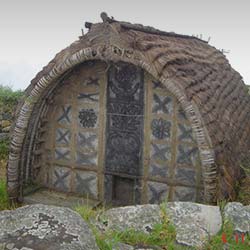
About The Toda Temple The Toda Temple located in Ooty, Tamil Nadu, is a sacred place of worship for the Toda tribe. The Toda people are an indigenous community of the Nilgiri Hills in southern India. The temple serves as a center for their religious and cultural practices, making it an important landmark in the region. Architecture of Toda Temple The Toda Temple is known for its unique architectural style, which is characteristic of the Toda tribe. The temple is constructed using wood and bamboo, with a thatched roof made of natural materials. The structure is simple yet elegant, reflecting the traditional building techniques of the Toda community. The temple's design is symbolic of the tribe's connection to nature and their reverence for the environment. History The history of the Toda Temple dates back several centuries, as the Toda tribe has inhabited the Nilgiri Hills for generations. The temple has played a central role in preserving the cultural heritage of the Toda people, serving as a place of worship and a gathering place for important ceremonies and rituals. The temple's history is closely intertwined with the history of the tribe, making it a significant cultural landmark in the region. Best Time To Visit The Toda Temple can be visited throughout the year, but the best time to experience its beauty and significance is during the Toda festivals and ceremonies. These events offer visitors a unique opportunity to witness the rich cultural traditions of the Toda tribe and participate in their celebrations. The temple is also a tranquil and peaceful place to visit for those seeking a spiritual retreat or a connection to nature. How To Reach The Toda Temple is located in the Nilgiri Hills near Ooty, making it accessible by road from the nearby towns and cities. Visitors can reach the temple by taking a taxi or a bus from Ooty, which is the nearest major town. The journey to the temple offers stunning views of the lush greenery and picturesque landscapes of the Nilgiri Hills, making it a memorable experience for travelers. Significance Of The Toda Temple The Toda Temple holds great significance for the Toda tribe, as it serves as a place of worship, community gathering, and cultural preservation. The temple is a symbol of the tribe's traditions, beliefs, and values, as well as their close connection to nature and the environment. Visiting the Toda Temple offers a glimpse into the unique heritage and way of life of the Toda people, making it a must-see attraction for those interested in learning about indigenous cultures in India. In conclusion, the Toda Temple in Ooty is not just a place of worship but a cultural and historical landmark that represents the rich heritage of the Toda tribe. Its unique architecture, deep-rooted history, and significance in the community make it a special destination for visitors looking to explore the cultural diversity of India. Whether you are seeking spiritual enlightenment or simply want to experience a different way of life, a visit to the Toda Temple is sure to leave a lasting impression on your mind and soul.
Explore More
About The Vekkali Amman Temple The Vekkali Amman Temple, located in Trichy, is a popular Hindu shrine dedicated to Goddess Vekkali Amman. The temple is known for its unique architecture, rich history, and spiritual significance. Devotees from different parts of the country visit this temple to seek blessings and fulfill their wishes. Architecture of Vekkali Amman Temple The Vekkali Amman Temple features a traditional Dravidian style of architecture, with intricately carved pillars, and colorful sculptures depicting various Hindu deities. The main sanctum sanctorum of the temple houses the idol of Goddess Vekkali Amman, adorned with flowers and jewels. The temple also has a large courtyard where religious ceremonies and rituals take place. History The history of the Vekkali Amman Temple dates back several centuries. According to local legends, the temple was built by a local ruler to honor Goddess Vekkali Amman, who is believed to be a form of Goddess Parvati. Over the years, the temple has undergone several renovations and additions, making it one of the most prominent religious sites in the region. Best Time To Visit The best time to visit the Vekkali Amman Temple is during the festivals and special occasions celebrated at the temple. The annual festival of the temple, known as the Vekkali Amman Thiruvizha, is a grand celebration that attracts thousands of devotees. The festival usually takes place in the months of March or April, coinciding with the Tamil New Year. How To Reach The Vekkali Amman Temple is located in Trichy, which is well-connected by road, rail, and air. The nearest airport is the Trichy International Airport, which is about 15 kilometers away from the temple. Visitors can also reach the temple by taking a bus or hiring a taxi from the Trichy bus stand or railway station. Significance Of The Vekkali Amman Temple The Vekkali Amman Temple holds great significance for the devotees who believe that worshipping Goddess Vekkali Amman can bring them peace, prosperity, and protection from evil forces. Many devotees offer special prayers and perform rituals at the temple to seek blessings for their families and loved ones. The temple is also believed to fulfill the wishes of those who pray with devotion and sincerity. In conclusion, the Vekkali Amman Temple in Trichy is a sacred place of worship that attracts devotees with its unique architecture, rich history, and spiritual significance. Visiting this temple can be a fulfilling and enriching experience for those seeking blessings and divine intervention in their lives.
Explore MoreKerala Tour Packages 7N - 8D
8 Days/ 7 Night
Kochi - Kovalam - Thekkady - Alleppey - Kanyakumari - Munnar
Tirupati to Arunachalam One Day Tour Package
1 Day
Tiruvannamalai - Vellore
7 Night Kanyakumari - Rameswaram - Madurai - Thekkady - Munnar Tour
8 Days/ 7 Night
Thekkady - Kanyakumari - Madurai - Rameshwaram - Munnar
8D Munnar - Thekkady - Alleppey - Kovalam - Kanyakumari Tour
8 Days/ 7 Night
Kovalam - Thekkady - Alleppey - Kanyakumari - Munnar

About The Ucchi Pillayar Temple The Ucchi Pillayar Temple, also known as the Rock Fort Temple, is a popular Hindu temple located in Trichy, Tamil Nadu. Situated on a massive rock formation that is over 83 meters high, the temple offers stunning panoramic views of the surrounding area. The temple is dedicated to Lord Ganesha, who is also known as Ucchi Pillayar in Tamil Nadu. Architecture of Ucchi Pillayar Temple The Ucchi Pillayar Temple is a fine example of Dravidian architecture. The temple complex is divided into three levels, each accessible by a series of steep steps carved into the rock. The lower level houses the Vinayakar shrine, while the middle level is home to a 7th-century Pallava cave temple dedicated to Lord Shiva. The upper level houses the Ucchi Pillayar Temple dedicated to Lord Ganesha. The highlight of the temple is the giant rock-cut idol of Lord Ganesha, which stands at an impressive height of 6 feet. The idol is believed to be one of the largest in Asia and is a major attraction for devotees and tourists alike. History The Ucchi Pillayar Temple has a rich historical significance. It is believed that the rock on which the temple is built is over 3 billion years old. The temple complex has been a place of worship for centuries, with the earliest inscriptions dating back to the 3rd century BC. The temple has undergone several renovations and expansions over the centuries, with major contributions made by various ruling dynasties such as the Cholas, Pallavas, and Vijayanagara rulers. Best Time To Visit The best time to visit the Ucchi Pillayar Temple is during the winter months of November to February when the weather is pleasant and conducive for exploring the temple complex. The temple is also less crowded during this time, allowing visitors to enjoy the serene atmosphere and architectural marvels at their own pace. How To Reach The Ucchi Pillayar Temple is easily accessible by road, rail, and air. The nearest airport is Tiruchirapalli International Airport, which is located approximately 10 kilometers away from the temple. Trichy Junction is the nearest railway station, and there are regular trains connecting Trichy to major cities in Tamil Nadu and other parts of India. Visitors can also reach the temple by road via NH38, which connects Trichy to other major cities in Tamil Nadu. Significance Of The Ucchi Pillayar Temple The Ucchi Pillayar Temple holds great religious significance for devotees of Lord Ganesha. It is believed that worshipping Lord Ganesha at this temple can help in removing obstacles and bringing prosperity and success in one's life. The temple is also considered a sacred pilgrimage site for Hindus, who visit the temple to seek the blessings of Ucchi Pillayar for their well-being and fulfillment of their wishes. In addition to its religious significance, the Ucchi Pillayar Temple is also a popular tourist destination, attracting visitors with its stunning architecture, panoramic views, and rich historical heritage. The temple's serene ambiance and spiritual aura make it a must-visit destination for those seeking solace and divine blessings.
Explore More
About The Shesharayar Mandapam Temple The Shesharayar Mandapam Temple is located in Trichy, a city in the southern state of Tamil Nadu, India. It is a unique temple dedicated to Lord Vishnu and is known for its beautiful architecture and historical significance. The temple is also popularly known as the Aayiram Kaal Mandapam, which translates to a thousand-pillared hall. The temple is a prominent tourist attraction in Trichy and is visited by devotees and tourists alike. Architecture of Shesharayar Mandapam Temple The Shesharayar Mandapam Temple is renowned for its intricate carvings and exquisite architecture. The temple features a stunning thousand-pillared hall with intricately carved pillars that showcase the skilled craftsmanship of ancient artisans. The hall is adorned with sculptures of various gods and goddesses, along with elaborate designs that reflect the rich cultural heritage of the region. The temple's architecture is a blend of Dravidian and Vijayanagara styles, making it a sight to behold for visitors. History The Shesharayar Mandapam Temple has a long and fascinating history that dates back to the 17th century. The temple was built by the Nayak king, Rani Mangammal, in honor of her husband, Shesharayar, who was a brave warrior. Legend has it that the temple was constructed as a symbol of love and devotion towards her husband. The temple's historical significance and architectural beauty have made it a revered site for pilgrims and history enthusiasts. Best Time To Visit The best time to visit the Shesharayar Mandapam Temple is during the winter months, from November to February, when the weather is pleasant and ideal for sightseeing. The temple is less crowded during this time, allowing visitors to explore its beauty in peace. It is recommended to visit the temple early in the morning or late in the afternoon to avoid the midday heat and enjoy the serene ambience of the temple. How To Reach The Shesharayar Mandapam Temple is easily accessible by road, rail, and air. Trichy is well-connected to major cities in Tamil Nadu and other parts of India, making it convenient for visitors to reach the temple. The nearest airport is the Tiruchirappalli International Airport, located about 7 kilometers from the temple. Trichy Junction is the nearest railway station, with regular trains connecting the city to various destinations. Visitors can also hire taxis or auto-rickshaws to reach the temple from the city center. Significance Of The Shesharayar Mandapam Temple The Shesharayar Mandapam Temple holds great religious and cultural significance for devotees and visitors. The temple is dedicated to Lord Vishnu, one of the principal deities in Hinduism, and is believed to bring blessings and prosperity to those who visit and offer prayers. The thousand-pillared hall is a unique feature of the temple and is considered an architectural marvel. The temple's serene surroundings and spiritual ambience make it a popular destination for meditation and spiritual retreats. Overall, the Shesharayar Mandapam Temple is a must-visit for those seeking a blend of history, culture, and spirituality.
Explore More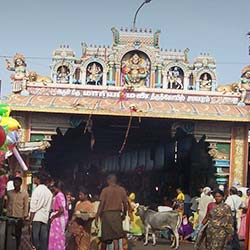
About The Samayapuram Mariamman Temple The Samayapuram Mariamman Temple is a famous Hindu temple dedicated to Goddess Mariamman, located in Samayapuram, near Trichy in the state of Tamil Nadu, India. The temple is considered one of the most powerful and popular temples in the region and attracts thousands of devotees every day. Architecture of Samayapuram Mariamman Temple The temple complex is built in the Dravidian style of architecture and is known for its exquisite sculptures and intricate carvings. The main deity, Goddess Mariamman, is housed in a sanctum sanctorum adorned with colorful paintings and decorations. The temple also features a large tank, pillared halls, and a majestic gopuram (gateway tower) at the entrance. History The history of the Samayapuram Mariamman Temple dates back to several centuries. According to legend, the idol of Goddess Mariamman was found by a farmer while plowing his fields. The idol was believed to have miraculous powers, and a temple was built at the site to worship the goddess. Over the years, the temple has undergone renovations and expansions, making it the grand structure it is today. Best Time To Visit The best time to visit the Samayapuram Mariamman Temple is during the annual festivals and special occasions when the temple is beautifully decorated and lit up. The most popular festival celebrated at the temple is the Samayapuram Mariamman Brahmotsavam, which takes place in the Tamil month of Vaikasi (May-June). How To Reach The Samayapuram Mariamman Temple is easily accessible from Trichy, which is well-connected by road, rail, and air. The temple is located about 20 kilometers from Trichy and can be reached by car or public transportation. Visitors can also hire a taxi or auto-rickshaw to reach the temple from the city. Significance Of The Samayapuram Mariamman Temple The Samayapuram Mariamman Temple is known for its healing powers and is believed to cure various illnesses and diseases. Devotees offer prayers and offerings to the goddess seeking her blessings for good health and prosperity. The temple is also a popular pilgrimage site for those seeking protection from evil spirits and black magic. In conclusion, the Samayapuram Mariamman Temple is a sacred place of worship dedicated to Goddess Mariamman, known for its rich history, beautiful architecture, and significance in the Hindu faith. Visiting this temple is a unique and spiritual experience that allows devotees to connect with the divine and seek blessings for a prosperous life.
Explore More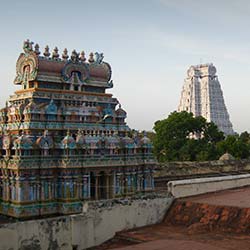
The Ranganathaswamy Temple, also known as Thiruvarangam Temple, is a famous Hindu temple dedicated to Lord Ranganatha, a reclining form of Lord Vishnu. Located in Srirangam, near Trichy in the state of Tamil Nadu, India, this temple is one of the most revered temples in South India and holds a significant place in Hindu mythology and history. About The Ranganathaswamy Temple The Ranganathaswamy Temple is spread over an area of 156 acres, making it the largest functioning temple in the world. It is enclosed by seven concentric walls, known as prakarams, and has 21 gopurams (gateway towers) with the Rajagopuram, the main tower, standing tall at 236 feet. The temple complex also includes several small shrines, tanks, and gardens, adding to the grandeur and charm of the place. Architecture of Ranganathaswamy Temple The temple's architecture is a fine example of Dravidian style, with intricate carvings and sculptures adorning the walls and pillars. The main sanctum sanctorum houses the idol of Lord Ranganatha in a reclining position on the coiled Adi Sesha (celestial serpent). The temple's corridors are filled with mandapas and halls, each showcasing unique architectural features and designs. History The history of the Ranganathaswamy Temple dates back to the 10th century when it was built by the Chola dynasty. Over the centuries, various rulers including the Nayaks and the Vijayanagara Empire made significant contributions to the temple's architecture and infrastructure. The temple has also witnessed invasions and plundering by different dynasties, but it has always stood strong, symbolizing resilience and devotion. Best Time To Visit The best time to visit the Ranganathaswamy Temple is during the months of September to April when the weather is pleasant and conducive for exploring the temple complex. The temple also hosts several festivals and events during this time, attracting a large number of devotees and tourists from all over the country. How To Reach The Ranganathaswamy Temple is easily accessible by road, rail, and air. The nearest airport is the Trichy International Airport, located about 10 kilometers away from Srirangam. Trichy Junction is the nearest railway station, well-connected to major cities in India. Visitors can also hire taxis or take local buses to reach the temple from Trichy city. Significance Of The Ranganathaswamy Temple The Ranganathaswamy Temple holds immense religious and spiritual significance for Hindus, especially Vaishnavites. It is believed that a visit to the temple and offering prayers to Lord Ranganatha can help devotees attain salvation and spiritual enlightenment. The temple also plays a vital role in promoting cultural heritage and preserving ancient traditions through various rituals and ceremonies conducted throughout the year. In conclusion, the Ranganathaswamy Temple is not just a place of worship but a symbol of faith, devotion, and architectural brilliance. Its rich history, intricate architecture, and spiritual ambiance make it a must-visit destination for those seeking a glimpse into the cultural heritage of India.
Explore More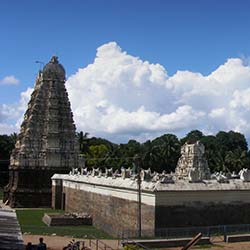
About The Jalakandeswarar Temple The Jalakandeswarar Temple is a famous Hindu temple dedicated to Lord Shiva located in Vellore, Tamil Nadu. It is known for its exquisite architecture, intricate carvings, and historical significance. The temple is a popular pilgrimage site for devotees from all over the country who come to seek the blessings of Lord Shiva. Architecture of Jalakandeswarar Temple The Jalakandeswarar Temple is a fine example of Dravidian architecture and dates back to the 16th century. The temple is built in the Vijayanagara style and is known for its intricate carvings, sculptures, and gopurams. The main shrine of Lord Shiva is surrounded by smaller shrines dedicated to various deities. The temple also has a large tank known as Surya Pushkarini, which adds to its beauty. History The Jalakandeswarar Temple has a rich history that dates back to the Vijayanagara Empire. It is believed that the temple was built by the Vijayanagara rulers in the 16th century. The temple has undergone several renovations and additions over the years, including the construction of the gopurams and the tank. The temple also has inscriptions that provide insights into its history and significance. Best Time To Visit The best time to visit the Jalakandeswarar Temple is during the months of October to March when the weather is pleasant and suitable for exploring the temple complex. The temple also hosts several festivals and rituals during this time, making it a vibrant and lively place to visit. It is recommended to avoid visiting the temple during the summer months as the temperatures can be quite high. How To Reach The Jalakandeswarar Temple is located in Vellore, Tamil Nadu, and is easily accessible by road, rail, and air. The nearest airport is the Chennai International Airport, which is approximately 130 kilometers away from the temple. The Vellore Cantonment Railway Station is the nearest railhead, and there are regular trains connecting Vellore to major cities in Tamil Nadu and other parts of the country. The temple is also well-connected by road, and there are frequent bus services from Vellore and other nearby towns. Significance Of The Jalakandeswarar Temple The Jalakandeswarar Temple holds great significance for devotees of Lord Shiva. It is believed that worshipping at the temple can bring blessings, prosperity, and peace to the devotees. The temple is also associated with several legends and myths that add to its mystique and allure. The annual festivals and rituals at the temple attract a large number of devotees who come to seek the blessings of Lord Shiva. In conclusion, the Jalakandeswarar Temple in Vellore is not just a place of worship, but also a testament to the rich history and culture of Tamil Nadu. The temple's exquisite architecture, historical significance, and spiritual aura make it a must-visit destination for those seeking a spiritual experience. Whether you are a devout follower of Lord Shiva or a history enthusiast, the Jalakandeswarar Temple is sure to leave you mesmerized and awestruck.
Explore More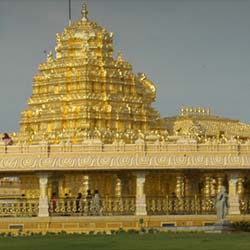
About The Sripuram Golden Temple The Sripuram Golden Temple, located in the city of Vellore in Tamil Nadu, is a spiritual and architectural marvel that attracts thousands of devotees and tourists every year. This magnificent temple is dedicated to Goddess Mahalakshmi, the goddess of wealth and prosperity, and is known for its stunning golden exterior that shines brightly in the sunlight. Architecture of Sripuram Golden Temple The Sripuram Golden Temple is a unique blend of traditional and modern architectural styles. The temple complex is built on a sprawling 100-acre site and features exquisite carvings, intricate designs, and beautiful sculptures. The main structure of the temple is covered in pure gold foil, giving it a radiant and striking appearance. The temple is surrounded by lush green gardens, serene water bodies, and ornate pathways, creating a peaceful and spiritual atmosphere. History The Sripuram Golden Temple was built by the Sri Narayani Peedam, a spiritual organization that aims to promote peace, harmony, and spirituality. The construction of the temple began in 2001 and was completed in 2007. The temple is dedicated to Goddess Mahalakshmi, who is believed to bestow wealth, prosperity, and blessings upon her devotees. The Sripuram Golden Temple stands as a symbol of faith, devotion, and divine grace. Best Time To Visit The best time to visit the Sripuram Golden Temple is during the early morning or evening hours when the temple is less crowded and the weather is pleasant. The temple is open to visitors throughout the year, but it is recommended to avoid visiting during peak hours or festivals when the temple can get overcrowded. The tranquil surroundings of the temple make it an ideal place for meditation, reflection, and spiritual rejuvenation. How To Reach The Sripuram Golden Temple is located in Thirumalaikodi, about 8 kilometers from the city of Vellore. The temple is well-connected by road, and visitors can easily reach the temple by car, bus, or taxi. The nearest railway station is Vellore Cantonment, which is about 10 kilometers away from the temple. The nearest airport is Chennai International Airport, which is about 140 kilometers from the temple. Visitors can also opt for guided tours or private transportation services to reach the temple comfortably. Significance Of The Sripuram Golden Temple The Sripuram Golden Temple holds immense significance for devotees and pilgrims who seek blessings, guidance, and spiritual enlightenment. The temple is believed to be a powerful source of positive energy, divine grace, and prosperity. Many devotees visit the temple to offer prayers, perform rituals, and seek blessings from Goddess Mahalakshmi. The serene and tranquil ambiance of the temple creates a sense of peace, calmness, and inner harmony, making it a sacred and sacred place of worship.
Explore More